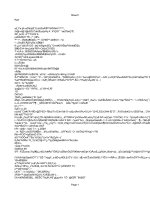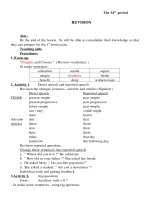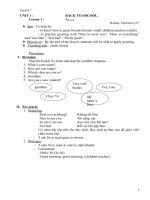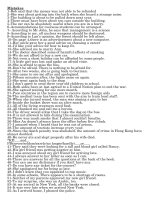Giao an Tieng Anh
Bạn đang xem bản rút gọn của tài liệu. Xem và tải ngay bản đầy đủ của tài liệu tại đây (110.45 KB, 20 trang )
<span class='text_page_counter'>(1)</span>Week: Class: 7A1, 7A2. UNIT: 13 Period: 81 Lesson: A (1,2). Date of preparation : March,20th 2006 Date of teaching : March,21st 2006. ACTIVITIES SPORTS. I. Aims and Objectives: * Language content: To help the students describe sporting activities. To introduce some new words relating to sport and some adjectives. * Language function: To help the students say the sports they like and they play in their free time. * Educational aim: To educate the students to aware of the importance of the sports in our life. 1. Language: a. Vocabulary: skateboarding, roller-skating, Roller-blading, choice, even though, surprising, surprisingly. b. Structures: The simple past tense. 2. Skills : Integrated skills. 3. Education factor: Knowing how to keep our health by playing sport. II. Teacher and students’ preparation: 1. Method: Communicative approach 2. Techniques: Reading comprehension, Pair work, explanation, Using picture. 3.Materials needed: Text - book , pictures. 4. Students’ preparation: picture, new lesson 5. Previous exercises: 1 + 2 + 3 + 4 + 5 +/ 124, 125, 126, 127. III. Procedure in class: 1. Stabilization: (2 ms) a. Warm – up: Greeting b. Checking absence: Who’s absent today? 2. Checking up the previous knowledge: (5 ms) .Questions: - Has the students complete the sentences with, so, too, either and neither: 1- Hoa and Nga didn’t go to school and Nam …. 2- I’m not a teacher and ….. he..
<span class='text_page_counter'>(2)</span> 3- My mother likes chocolates and ….. I. 4- He can speak Chinese. I ….. 3.Presentation of the new materials: time Teacher’s activities Students’activities 4ms. 8ms. I ./Lead_in Questions: . What do you usually do in your free time? . Do you often play sports? . Which sports do you like to play? how often? -Says and introduces the situation :”Today, we will study some sports which sts in Vietnam and in the USA like playing in their free time”. II./Pre-pratice -Plays the cassette once 1 Writes and teaches the words - surprising (a) (explain) - surprisingly (adv) : - skateboarding: (picture) - rollerblading: - roller- skating - choice (n): (translation) 2 Checks the meanings of the words “ Using. -Answer the Q. The content of the new lesson UNIT: 13. ACTIVITIES. Period: 81 Lesson: A (1,2) SPORTS -Listen and know the title and aims of the lesson .Write the title of the lesson. -Listen to the tape -Listen ,repeat, guess * Writes and teaches the meaning and then the words copy down - surprising (a) - surprisingly (adv) : - skateboarding: rollerblading: - roller- skating choice -Have a look at the picture and say the meaning..
<span class='text_page_counter'>(3)</span> 11ms. 5ms. 5ms. the pictures and asks them to say the meaning of the words” 3 Grammar - Reminds of the simple past tense: Ex: Baseball was the most popular choice even though it is not one of the world’s most popular game. III/ Controlled-practice -Asks the sts to listen to the tape twice. -Asks them to read the text in silently and answer the questions. a. What are the ten most popular sports ? b. Is baseball your favorite sports? If not, what is your first choice? c. Do you like table tennis? - Asks them to practice in pairs, asking and answering the questions. - Corrects their mistakes. IV/Free- practice: -Asks the sts to practice in pairs, asking and answering their favorite sports. V./ Consolidation -Asks the sts to tell the. -Have a look, remember and take notes. * The simple past tense: Ex: Baseball was the most popular choice even though it is not one of the world’s most popular -List some more sentences using the past game. simple tense.. -Listen to the tape -Read and takes roles and practice in pairs -Answer. - Practice in pairs.. -Make their own conversation.. - Tell the differences. 3.Answer the questions : a. They are: 1. baseball 2. Skateboarding 3. Roller-skating 4. Rollerblading 5. Basket ball 6. Football 7. Volleyball 8. Tennis 9. Badminton 10.Swimming b. Yes/ no it is not. - My first choice is……… c. Yes/ no…….
<span class='text_page_counter'>(4)</span> differences between the most popular sports for students in Vietnam and in the USA. - Listen and take - Listens and gives more notes. ideas. 4/ Homework: 3ms Asks the sts to write down on their notebooks -Learn the lesson well - Do exercises 1 + 2 / 130. 5/ Preparation for the next lesson(2mins ) -Vocabulary on medical check-up 6/ Self-evaluation.
<span class='text_page_counter'>(5)</span> Week: Class: 7A1, 7A2. UNIT: 13 Period: 81 Lesson: A (3,5). Date of preparation : March,24th 2006 Date of teaching : March,25th, 2006. ACTIVITIES SPORTS. I. Aims and Objectives: * Language content: - To introduce some new words relating to sport and the way to form adverbs of manner from adjectives. * Language function: - To help the students know how to make adv from adj. * Educational aim: - To educate the students to aware of the importance of sport. 1. Language: a. Vocabulary: skillful – skillfully, slow – slowly, bad – badly, good – well. b. Structures: Formation of adv : adj + ly -> adv. He’s a good soccer player. He plays well. 2. Skills : Integrated skills. 3. Education factor: Knowing how to keep our health by walking. II. Teacher and students’ preparation: 1. Method: Communicative approach 2. Techniques: Repetition, Pair work, Explanation, Using picture. 3.Materials needed: Text - book , pictures. 4. Students’ preparation: picture, new lesson 5. Previous exercises: 2/ 130. III. Procedure in class: 1. Stabilization: (2 ms) a. Warm – up: Greeting b. Checking absence: Who’s absent today? 2. Checking up the previous knowledge: (5 ms) * Questions: - Has the students read the text then write new words after that answer the questions:.
<span class='text_page_counter'>(6)</span> . What sports do you like? . And what sports do you play in your free time? . What sports do teenagers in the USA usually play? 3. Presentation of the new materials: time Teacher’s activities Students’activities 3ms. 9ms. The content of the new lesson. I ./Lead_in - Asks them to look at UNIT: 13 the picture and asks some -Answer the Q ACTIVITIES questions: Period: 81 . Who is he? Lesson: A (3,5) . What is he doing? SPORTS . Which sports does he play? . How does he play? -Says and introduces the -Listen and know the title and aims of the situation lesson .Write the title of the lesson II./Pre-pratice -Listen to the tape -Plays the tape 1 Writes and teaches -Listen ,repeat, guess the meaning and then the words copy down - skillful (adj) * Writes and teaches skillfully (adv): the words (picture) - skillful (adj) - slow (adj)- slowly skillfully (adv): (adv) (picture) (picture) - quickquickly: - slow (adj)- slowly (picture) (adv) (picture) - bad – badly: - quickquickly: - safe- safely: (picture) -Have a look at the 2 Checks the meanings - bad – badly: of the words “ Using picture and say the - safe- safely: meaning. the pictures and asks.
<span class='text_page_counter'>(7)</span> 13ms. them to say the meaning of the words” 3 Grammar - Explains the formation of adverbs of manner from adjectives. Adj + ly -- Adv Slow + ly – slowly * Note: - Adj: stands before a noun and after linking verbs or “to be”. - Adv: stands after ordinary , adj or another adverbs. Ex: She is a bad tennis player. She plays tennis badly. III/ Controlled-practice -Asks the sts to listen to the tape again. -Have them practice in pairs (in book). - Calls some pairs to practice. * Asks them to read exercise 5 “Change the adjectives in brackets to adverbs” - Explains some difficult words: . strict: (adj): . obey (v): . lifeguard (n) : - Gives them time to. -Have a look, remember and take notes - Take notes.. -Listen to the tape. * Formation of adverbs of manner from adjectives. Adj + ly -- Adv Slow + ly – slowly * Note: - Adj: stands before a noun and after linking verbs or “to be”. - Adv: stands after ordinary , adj or another adverbs. Ex: She is a bad tennis player. She plays tennis badly.. - Takes roles and practice in pairs. -Do exercise. - Listen and take notes.. - Practice writing.. * feedback: (1): clearly (2): carefully.
<span class='text_page_counter'>(8)</span> 4ms. 4ms. write. - Calls some to give feedback. - Corrects their mistakes. -Make their own IV/Free- practice: -Asks the sts to practice sentences in pairs, one use an adjective or adverb, one make a sentence to describe an activity that they know. - Do exercise V./ Consolidation - Has the sts to choose the correct words: 1: My brother plays the guitar (bad/ badly). 2: My teacher sings that song (good/ well) 3: It is an (interesting/ interestingly) story. 4: You should listen your teacher (careful/ carefully).. (3): safely (4) carelessly (5) strictly. * Remember: She is a bad tennis player. She plays tennis badly. Good – well Skillful- skillfully Slow- slowly Bad – badly Sudden – suddenly Interesting- interestingly. 4/ Homework: 3ms Asks the sts to write down on their notebooks -Learn the lesson well - Make 6 sentences using adjectives and adverbs the learnt. 5/ Preparation for the next lesson(2mins ) - Prepare A4. 6/ Self-evaluation.
<span class='text_page_counter'>(9)</span> Week: Class: 7A1, 7A2. UNIT: 13 Period: 81 Lesson: A (3,5). Date of preparation : March,24th 2006 Date of teaching : March,25th, 2006. ACTIVITIES SPORTS. I. Aims and Objectives: * Language content: - To introduce some new words relating to sport. - To help the students understand the content of the text “walking is Fun” and practice comprehension. * Language function: - To help the students do the exercise well. * Educational aim: - To educate the students to aware of the importance of sport. 1. Language: b. Vocabulary: district, competition, to win, prize, wish, organize, participant, increase, volunteer, inexpensive, ability. b. Structures: 2. Skills : Integrated skills. 3. Education factor: Knowing how to keep our health by walking. II. Teacher and students’ preparation: 1. Method: Communicative approach 2. Techniques: Repetition, Pair work, Explanation, Using picture. 3.Materials needed: Text - book , pictures. 4. Students’ preparation: picture, new lesson 5. Previous exercises: 2/ 130. III. Procedure in class: 1. Stabilization: (2 ms) a. Warm – up: Greeting b. Checking absence: Who’s absent today? 2. Checking up the previous knowledge: (5 ms).
<span class='text_page_counter'>(10)</span> * Questions: - Has the st to choose the correct words: 1: My elder brother plays the chess (bad/ badly). 2: My teacher read that story (fluent / fluently) 3: It is an (interesting/ interestingly) poem. 4: You should listen to the lifeguard (careful/ carefully). 3. Presentation of the new materials: time Teacher’s activities Students’activities 3ms. 9ms. The content of the new lesson. I ./Lead_in - Asks them to look at UNIT: 13 the picture and asks some -Answer the Q ACTIVITIES questions: Period: 81 . What are they? Lesson: A (4) . What are they doing? SPORTS . Do you ever walk in the morning? . How do you feel? -Says and introduces the -Listen and know the title and aims of the situation lesson .Write the title of the lesson II./Pre-pratice 1 Writes and teaches -Listen ,repeat, guess the meaning and then the words copy down - competition (n) - win (v): (explanation) * Writes and teaches - prize (n) the words - wish: (v) - competition (n) (explanation) - win (v): (explanation) - organize (v) - prize (n) - increase (v) - wish: (v) - walk-to-school day (explanation) (picture) - organize (v) - increase (v).
<span class='text_page_counter'>(11)</span> 13ms. 4ms. 2 Checks the meanings of the words “ slap the board” - Asks them to guess True/ False predictions: a. Walking is boring b. There was a district walking competition for school children last year. c. His school team didn’t win the competition. d. A few people take part in this club. III/ Controlled-practice -Asks the sts to read the text quickly and answer the question: . What is WFF? - Asks them to reread and answer the questions in book. - Asks them to practice with their partner, asking and answering the questions. - Calls some to say. - Calls some pairs to practice. - Corrects their mistakes. IV/Free- practice: -Asks the sts some question: . Are there any club at your school? . Which club do you want. - Slap the board.. - walk-to-school (picture). day. -Have a look, think and guess.. - Read and answer the question.. * Feedback: a. The writer takes part in walking. b. Because last year, his - Reread and answer the school team won the first question in book. prize and everybody was so happy to keep this - Practice in pairs, activity. asking and answering the questions.. - Answer themselves..
<span class='text_page_counter'>(12)</span> 4ms. to take part in? . How often do you join in this club? V./ Consolidation - Asks them to - Summarize the content summarize the content of of the lesson. the lesson. 4/ Homework: 3ms Asks the sts to write down on their notebooks -Learn the lesson well - Translate the reading into Vietnamese. 5/ Preparation for the next lesson(2ms ) - Prepare B1,2. 6/ Self-evaluation.
<span class='text_page_counter'>(13)</span> Week: Class: 7A1, 7A2. UNIT: 13 Period: 82 Lesson: B (1,2). Date of preparation : March,24th 2006 Date of teaching : March,25th, 2006. ACTIVITIES COME AND PLAY. I. Aims and Objectives: * Language content: - To introduce some new words relating to sports and leisure time. - To help the students get accustomed to Modal verbs: should, must, have to, ought to. * Language function: - To help the students know how to give invitations and their responses. * Educational aim: - To educate the students aware of their duty or what they have to do after school and what they should do in their free time. 1. Language: c. Vocabulary: Ought to, table tennis paddle, spare, borrow. b. Structures: Modal verbs Invitations and refusals / responses. It take sb time to do something. 2. Skills : Integrated skills. 3. Education factor: Knowing how to study and relax scientifically II. Teacher and students’ preparation: 1. Method: Communicative approach 2. Techniques: Repetition, Pair work, Explanation, Using picture, mapped dialogue. 3.Materials needed: Text - book , pictures. 4. Students’ preparation: picture, new lesson 5. Previous exercises: III. Procedure in class: 1. Stabilization: (2 ms) a. Warm – up: Greeting b. Checking absence: Who’s absent today?.
<span class='text_page_counter'>(14)</span> 2. Checking up the previous knowledge: (5 ms) * Questions: - Has the st to fill in the blank. 1: My elder brother plays the piano (good\ well). 2: I always feel ( nervous/ nervously) before examination. 3: It is an (interesting/ interestingly) book. 4: You should listen to the lifeguard (careful/ carefully). 3. Presentation of the new materials: time Teacher’s activities Students’activities 3ms. 9ms. The content of the new lesson. I ./Lead_in - Asks them some UNIT: 13 -Answer the Q questions: ACTIVITIES .Do you often play Period: 82 volleyball? Lesson: B (1,2) . Do you play tennis? COME AND PLAY . What sports do you like to play? - Look at the picture - Shows the picture: and answer. . What are Ba and Nam doing? . Can you play it? -Says and introduces the -Listen and know the situation title and aims of the lesson .Write the title of the lesson II./Pre-pratice - Plays the cassette one. -Listen ,repeat, guess * Writes and teaches 1 Writes and teaches the meaning and then the words copy down the words - Ought to = must: - Ought to = must: - Table tennis paddle (modals) ( nphr): - Table tennis paddle spare (a) : ( nphr): (picture) - borrow: (v) # : lend - spare (a) :.
<span class='text_page_counter'>(15)</span> (explanation) - borrow: (v) (antonym) : lend. 13ms. 4ms. 2 Checks the meanings of the words - Uses the picture, synonym, matching 3. Grammar: - Modals: S + ought to/ must/ may/ might + V. Ex: You should relax. - Reviews the sts the suggestion/ invitation. - It takes O + time + toinf III/ Controlled-practice * B1: Plays the cassette - Lets the sts work in pairs: taking the roles (asking and answering the questions). - Has them answer, write, and corrects the mistakes. * B2; Explains the requirements and have the sts to practice the dialogue. - Calls them to read - Has them write.. -Have a look at the picture, synonym or listen to the translation and then produce the words.. - Corrects their mistakes. IV/Free- practice:. - Listen. - Take notes and gives examples.. 3. Grammar: - Modals: S + ought to/ must/ may/ might + V. Ex: You should relax. - Reviews the sts the suggestion/ invitation. - It takes O + time + toinf. - Take notes.. - Listen and practice. - Answer and write.. - Listen and practice.. - Practice. * Feedback: a. He should do his homework before he plays table tennis. b. Nam will be ready a few more minutes. c. Ba will finish his Math d. Ba has two paddles..
<span class='text_page_counter'>(16)</span> 4ms. -Asks them to make their own dialogues. - Calls some pairs to practice. V./ Consolidation - Asks them to make dialogues, using the map: Nhi: Would/ soccer? Ba: (refuse) Nhi: (response) Ba: I/ home work Nhi: I/ wait.. - Make their own dialogues and practice.. - Make a dialogue, using the map.. 4/ Homework: 3ms Asks the sts to write down on their notebooks -Learn the lesson well - Do exercise: 5/ Preparation for the next lesson(2mins ) - Prepare B3,4*. 6/ Self-evaluation.
<span class='text_page_counter'>(17)</span> Week: Class: 7A1, 7A2. UNIT: 13 Period: 83 Lesson: B (3,4 ). Date of preparation : April, th 2006 Date of teaching : April, th, 2006. ACTIVITIES COME AND PLAY. I. Aims and Objectives: * Language content: - To introduce some new words about a strange new sport called diving. - To help the students know and review the use of Modals. * Language function: - To help the students know and understand the history of scuba-diving and the benefits of the sport. * Educational aim: - To broaden the sts’s knowledge about sports. - To make the sts aware of choosing their career, hobbies. 1. Language: d. Vocabulary: Surface, ocean, pearl diver, special breathing equipment, invent, scubadiving, a deep sea diving vessel, explore… b. Structures: Modal verbs - The past simple tense. 2. Skills : Integrated skills. 3. Education factor: II. Teacher and students’ preparation: 1. Method: Communicative approach 2. Techniques: Repetition, Pair work, Explanation, Using picture, blank fill. 3.Materials needed: Text - book , pictures. 4. Students’ preparation: picture, new lesson, and knowledge on diving. 5. Previous exercises: III. Procedure in class: 1. Stabilization: (2 ms) a. Warm – up: Greeting.
<span class='text_page_counter'>(18)</span> b. Checking absence: Who’s absent today? 2. Checking up the previous knowledge: (5 ms) * Questions: - Asks two sts to make a dialogue, talking about the sport they like. 3. Presentation of the new materials: time Teacher’s activities Students’activities The content of the new lesson 3ms I ./Lead_in - Asks them to look at - Look at the picture UNIT: 13 and answer. the picture and guess: ACTIVITIES . What’s sport? Period: 83 . Where can we play this Lesson: B (3,4 ) sport? COME AND PLAY . What can you see with the ability of scubadiving.? -Says and introduces the -Listen and know the title and aims of the situation lesson .Write the title of the lesson II./Pre-pratice 9ms 1 Writes and teaches -Listen ,repeat, guess the meaning and then the words copy down - Scuba-diving: (explanation) * Writes and teaches - Word’s surface the words ( nphr): (picture and - Scuba-diving: explanation) (explanation) - Pearl diver (n) : - Word’s surface (picture) ( nphr): (picture and - Special breathing explanation) equipment: : (n. phr) - Pearl diver (n) : (translation) : (picture) - Invent (v) : - Special breathing - Deep sea diving equipment: : (n. phr).
<span class='text_page_counter'>(19)</span> 13ms. 4ms. 4ms. vessel: (translation) - Under water life: 2. Checks the meanings of the words “rub out and remember) 3. Grammar: - Modals: S +( ought to/ must/ may/ might) not + V. Ex: You should relax. III/ Controlled-practice - Asks them to read the text quickly and answer the two questions: 1. Do we know well about the ocean? 2.Can people stay long under water with special breathing equipment? - Asks them to reread and find Tue/ False for the sentences on page 137. - Asks them to correct if the statement is false. - Corrects their mistakes. IV/Free- practice: -Asks them to work in group of three: one reads a statement, the other writes down, and the last evaluates T/F. make their own dialogues. V./ Consolidation - Blank fill: (can/ can’t) a: Now we c…………. - Rub out and remember. - Take notes and gives examples.. (translation) : - Invent (v) : Deep sea diving - vessel: (translation) - Under water life: 3. Grammar: Modals: S +( ought to/ must/ may/ might) not + V.. - Read and answer the two questions.. - Do exercise.. - Work in groups.. - Fill in. * Feedback: a: F b: T c: T d: F e: T.
<span class='text_page_counter'>(20)</span> explore the ocean. b: But we……….dive a deep-sea without special diving equipment.. 4/ Homework: 3ms Asks the sts to write down on their notebooks -Learn the lesson well - Do exercise: 5/ Preparation for the next lesson(2ms) - Prepare Unit 14 (A1),reread and vocabulary. 6/ Self-evaluation.
<span class='text_page_counter'>(21)</span>









